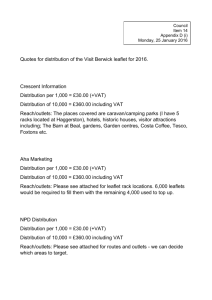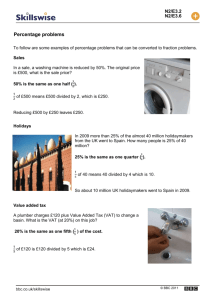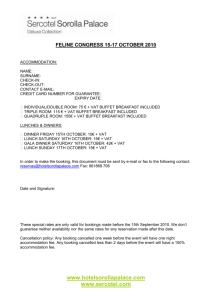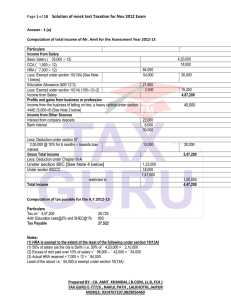Prezentácia programu PowerPoint
advertisement
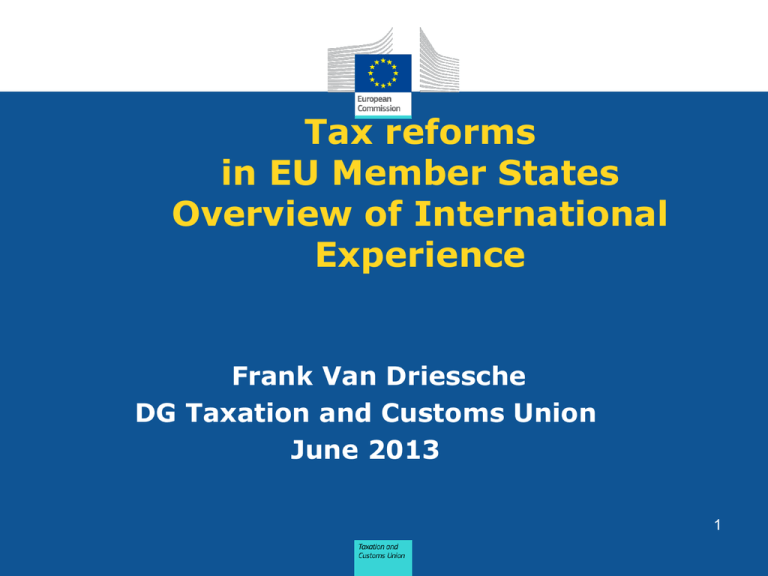
Tax reforms in EU Member States Overview of International Experience Frank Van Driessche DG Taxation and Customs Union June 2013 1 Content of the presentation • Trends in tax policy: a brief overview • Trends in tax administration: selected issues • Recent EU initiatives: an update 2 Tax revenues are increasing … in relation to GDP Total tax revenues as % of GDP % Source: Taxation trends in the European Union 2013 edition Top personal income tax rates are at their highest level since 2008 % Source: Taxation trends in the European Union 2013 edition The steep drop in corporate tax rates has levelled off Source: Taxation trends in the European Union 2013 edition VAT standard rates continue to rise Source: Taxation trends in the European Union 2013 edition Main trends: • Revenues - After the sharp decline in 2009, figures for 2011 show tax revenues have started to rise again. • Rates - VAT rates have increased strongly over the last four years. - Top personal income tax rates have risen to pre-crisis level. - Corporate income tax rates have levelled off. • Tax shift - Growth-friendly taxation: Increase in consumption taxes, small drop in labour taxes. 7 Trend in VAT GAP – 2000/2011- EU 27(*) 25.0 % 20.0 15.0 10.0 Gap share % Vat revenues, %gdp 5.0 0.0 2000 (*) Except CY 2001 2002 2003 2004 2005 2006 2007 2008 2009 2010 2011 Source: PCB and Case 2013-provisonal data Tax administration: selected issues • • • • • • • Institutional and organisational reforms. Strategies aimed at fostering voluntary compliance. Modernisation of debt collection. Performance management. Increasing use of modern electronic service delivery. An increasing challenge to tackle VAT fraud. Inter-agency cooperation. 9 Institutional and organisational reforms • Increased autonomy • Centralisation of management • Taxpayer segment-based structures 10 Fostering voluntary compliance • Building Trust – Transparency – Legal certainty • Enhanced compliance risk management. • Taxpayer segmentation; e.g. • - Large taxpayers. - High Wealth Individuals. - High Income Self-Employed. Treatment mix; e.g. - Communication. - Responsive regulation. Debt Collection • Average tax debt levels in OECD countries continued to ease in 2011, following their peak in 2009 (i.e. year following the global financial crisis). • Nevertheless there are significant increases in a number of countries. 80.00 70.00 60.00 2008 50.00 2009 40.00 30.00 2010 20.00 2011 10.00 AT BE BG CY CZ DK DE EE ES FI FR HU IE LU LT LV PL PT SI SK UK 12 Stock of VAT debt at the end of the year in percentage of annual VAT revenue (growth). 100% 80% 60% 2009-2011 40% 20% 0% UK HU SE LU NL AT BE IE EE FI FR PL DE BG CZ LT IT MT CY EL LV SK PT SI ES -20% -40% Source: Commission staff compilation 13 Main trends in debt collection • Non-sequential debt collection processes • Communication with debtors: e.g. outbound call centers • Integrated recovery process supported by automated identification of assets based on third party information • Merger of collection of taxes and SCC's. 14 Tackling VAT fraud • "Reverse charge" • • Quick reaction mechanism. • Optional application of VAT reverse charge. Proactive measures • Preventive measures at the pre-registration stage. • Post-registration monitoring. • Intelligence to detect missing traders at early stage. • De-registration of VAT Numbers. • EUROFISC. A whole of government approach • Reinforced cooperation with other law enforcement bodies: • Police. • Justice. • Social security authorities. • Anti-money laundering auth. Recent initiatives to combat tax fraud and evasion at European level • In December 2012, the Commission adopted a Communication containing an action plan to combat tax fraud and evasion at European Level • A yearly circle of economic policy coordination called "European Semester". • What gets measured gets managed; an EU-wide bench-marking for VAT. Thank you for your attention. Contact: frank.van-driessche@ec.europa.eu




